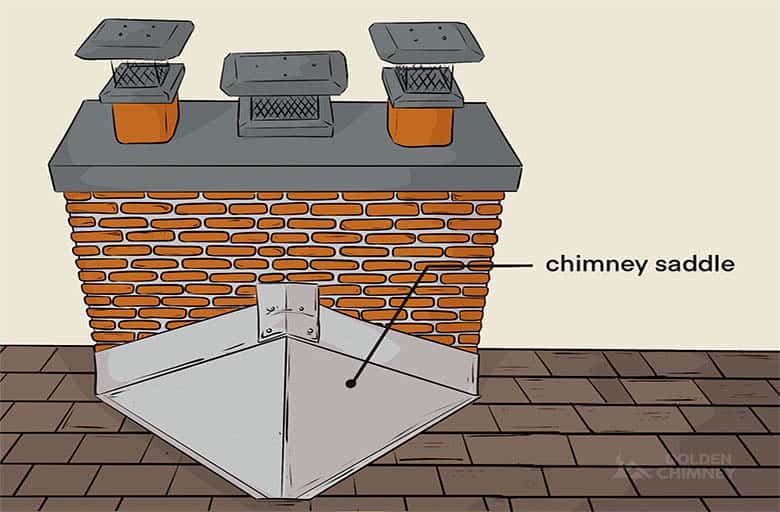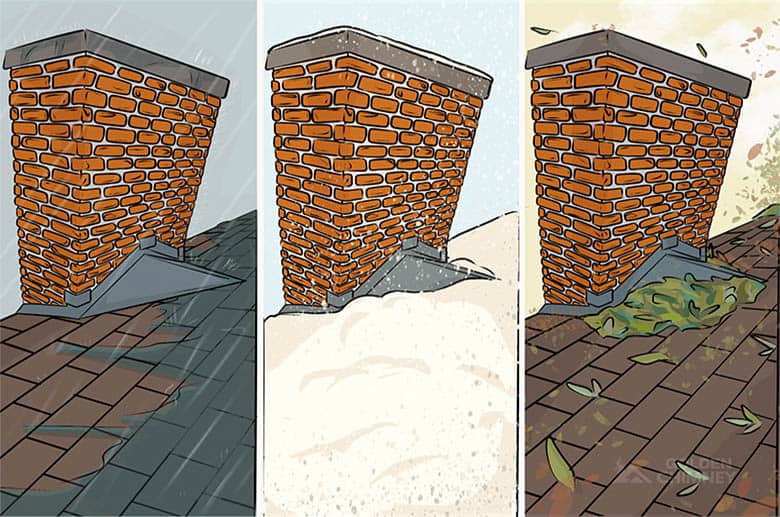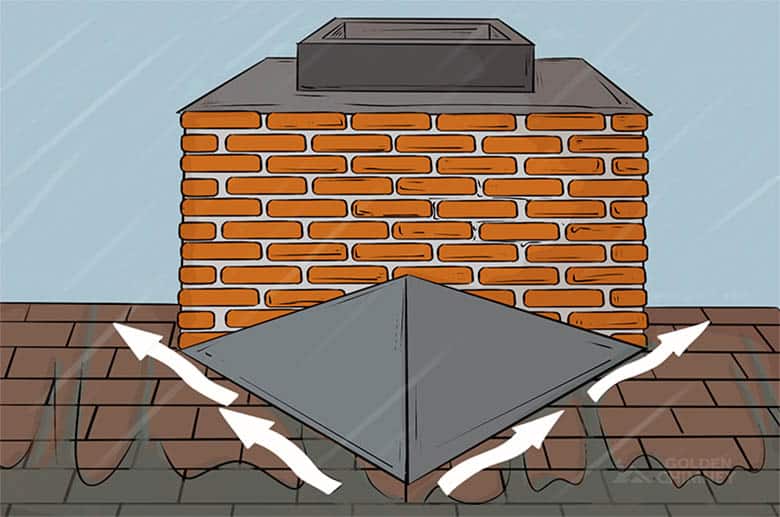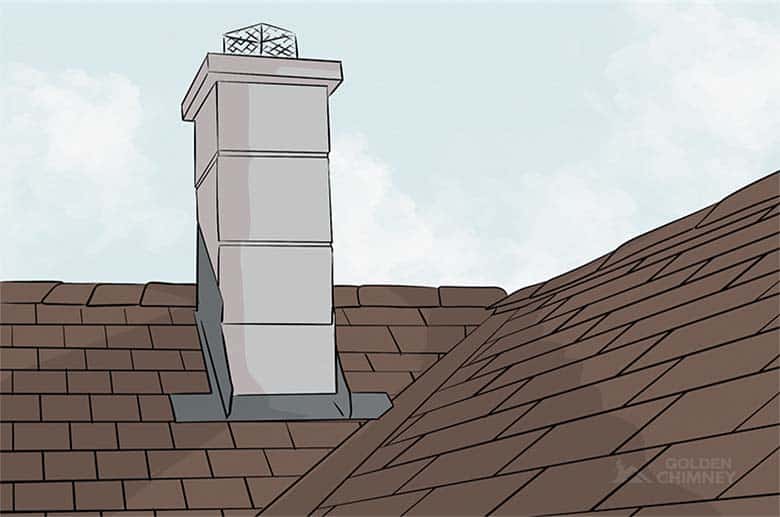Have you ever seen a chimney saddle and wondered what it is? If so, this post is for you! Chimney saddles are a vital part of your home’s roofing system.
We’ll cover the basics of chimney saddles and answer some of the most common questions homeowners have about them.
A chimney saddle is a common term for a flashing installed on a roof to waterproof the junction between the roof and the chimney.
Chimneys are often exposed to weathering and need this protection to keep water from seeping into the house’s structure.
If you’re considering installing a chimney saddle, here are some things you should know.
What is a chimney saddle?

A chimney saddle is a miniature tent-shaped roof installed on the area where the chimney meets the roof.
It is an integral part of the roofing system as it guarantees the longevity of your chimney. Chimney saddles are typically made of galvanized steel, copper, aluminum, and stainless steel. An important consideration here is knowing when should chimney flashing be replaced, as its condition directly impacts the effectiveness of the chimney saddle.
The chimney saddle can be added at the rear of the chimney when building a roof, especially if the roofing experts understand its importance.
Many houses don’t have a chimney saddle because some builders assume the chimney flashing is enough to prevent moisture from getting into the chimney masonry.
But this isn’t usually the case, as the constant exposure to water and snow leads to the deterioration of the flashing and chimney brick and mortar.
How do you know if your roof needs a chimney saddle? The first thing is to check the location of your chimney structure.
If it is at the roof’s slope, water and snow can accumulate at the base and destroy the flashing.
Another instance where a chimney saddle is necessary is if your chimney’s width (parallel to the roof slope) is more than 30 inches. If the chimney is wide, water tends to pool at the base and cause structural damage.
What is the purpose of a chimney saddle?
A chimney saddle serves the following functions:
Prevent water, snow, and debris from collecting around the base of the chimney

Chimney saddles are made of wooden frames and then covered by materials such as aluminum, stainless stee, and galvanized steel.
Most chimneys are located on the slope of the roof. When water pools around at the base of the chimney, it seeps into the masonry causing structural damage.
The angled sides of the chimney saddle direct water away from the chimney structure. Sometimes snow accumulates at the base of the chimney.
A saddle redirects the snow away and prevents water from settling around the flashing.
Protects the chimney from wear and leaks

Water leaking through the chimney is one of the main problems homeowners face. A chimney saddle prevents water from pooling around the flashing area.
The chimney flashing is usually waterproof, but prolonged exposure to water creates cracks and holes that allow water to seep into your chimney structure.
If you don’t deal with water damage issues early, you will ultimately spend thousands of dollars on water damage repairs. A certified chimney sweep can help you properly install a chimney sweep to prevent water leaks.
——
Do You Need to Hire Chimney & Fireplace Expert?
Get free quotes from qualified experts near you. No commitment required!
——
It makes the roof last longer
Water seeping in through the chimney structure can cause damage to your home’s roof.
Shingles are the most popular roofing materials in the United States. They are installed so that water freely cascades down into the gutter.
The shingles will not function normally when you don’t have a chimney saddle. Pools of water tend to form at the base of the chimney when they move down the roof.
Water enters the shingles and starts causing deterioration. Some common signs of damage on your roof include cracks on the shingles.
You may also notice pieces of shingles on the ground at the perimeter of your roof (washed down by rainwater).
Roofing shingles can last up to five decades, but they will need replacement after a few years when exposed to water damage. Installing a roof saddle enables you to avoid costly roofing repairs.

Prevents ice dams from forming on the roof
If there’s no saddle on the chimney, water pools at the base of the chimney when it snows or rains.
The water that settles at the connection between the chimney and the roof can damage the flashing and cause brick and mortar deterioration. During the winter, the pool of water freezes, forming an ice dam.
The ice dam prevents rainwater from moving down the roof into the gutter, Which means water will get into the chimney structure and cause damage.
If you notice an ice dam at the base of your chimney, call a chimney sweep to install a saddle immediately.
Prevents the chimney wall from blocking water flow
Your chimney is probably at the slope of your roof, which means water, debris, and snow move down towards it when they fall on your roof.
If you don’t have a chimney saddle, these elements will accumulate at the base of your chimney, and makes it difficult for the water to move away from the chimney structure.
The water will get into the chimney masonry and cause various water damage issues. For instance, excess moisture around the chimney structure can lead to cracked brick and mortar joints.
This allows more water to enter your chimney and leads to issues such as mold growth and a drafty fireplace.
When must a saddle be installed on a chimney?
A saddle is a vital part of the chimney structure. If you don’t have one, you will soon find yourself dealing with various water damage issues.
Here are some obvious signs that indicate the need for a chimney saddle:
- Signs of rotting if the chimney siding is made of wood (in prefabricated chimneys). Look for things like splintering and discoloration.
- Cracks and holes on the brick and mortar joints when water seeps through.
- Pieces of shingles on the gutter. This shows water is getting inside the shingles.
- Shards of flue tiles in the fireplace.
- Mold growth in the fireplace. This indicates the presence of excessive moisture in the chimney structure.
- Water stains on the ceiling near the chimney.
- Water spots on the walls. Peeling paint is a common sign.
These signs are associated with water leaking through the chimney. Remember, other problems like damaged chimney crowns and missing chimney caps can cause water leaks.
——
Do You Need to Hire Chimney & Fireplace Expert?
Get free quotes from qualified experts near you. No commitment required!
——
Do chimney saddles need a permit?
In most states, you require a permit to install chimney saddles.
It would be best if you were either a residential owner or a contractor.
According to the building codes in many states:
- A saddle or cricket shall be installed on the ridge side of a chimney or penetration that is over 30 inches or 762mm (width measured perpendicular to the roof slope).
- The material covering the roof saddle should be the same as the roof covering or metal.
A certified chimney sweep will advise on your state’s building code and help you properly install the saddle.
Does a chimney saddle draft better?
Chimney draft issues are common when a chimney is not functioning well. When your chimney leaks water, you will face many water damage issues like:
- Deteriorating chimney liner
- Leaning chimney
- Rusty damper
- Wood rot
These issues will cause drafting issues. If you keep operating your chimney without fixing the drafting issues, smoke and toxic gasses like carbon monoxide will eventually leak into your house and pose health risks.
Installing a chimney saddle is one of the best ways of preventing draft problems.
Do chimney saddle lengths matter?
Chimney saddle lengths matter. When building a saddle for your chimney, you must ensure you get all the measurements right. If you don’t, the structure won’t be effective as water will pool at the rear of the chimney and cause water damage.
A skilled chimney sweep will help you find the right lengths for your roof saddle.
Do chimney saddles make noise?
Chimney saddles are also referred to as chimney crickets. Despite sharing a name with the insect known for its chirping sounds, it does not make noise.
A saddle’s purpose is to prevent the accumulation of water, snow, and debris at the base of the side of the chimney facing the roof slope.
What is the difference between a saddle and a cricket?
There is no difference between a chimney saddle and a cricket. Both words are used to refer to the tiny roof installed on the area where the chimney meets the slope of the roof.
It is not uncommon to see builders or chimney sweeps use saddle and cricket interchangeably when referring to the tent-shaped flashing.
Factors that contribute to the cost of installing a chimney saddle
Chimney size – The chimney size is one of the main factors influencing chimney cricket prices. If the chimney is wide, you will need a bigger saddle, so you will likely spend more.
Roof materials – You can use metal or your roof’s material to cover the chimney cricket. Roofing materials differ in price. For example, asphalt shingles are more affordable than roof tiles. So if you have a tile roof, you will spend more than a homeowner whose roof is made of asphalt shingles.
Accessibility – How accessible is your chimney? Will special equipment or skills be needed to access your chimney and remove some of the roof materials to build the cricket? You will pay less for saddle installation if your chimney is easily accessible.
Labor costs – Installing a cricket on your chimney takes time. Some chimney sweeps will provide an hourly rate for the service, while some will offer a fixed rate for the time spent setting it up.
Current condition of the chimney – Before hiring a chimney sweep to install a cricket, consider your chimney’s condition. You may reach out to a chimney sweeper when your chimney has water damage issues, such as deteriorating brick and mortar. These issues must be fixed before a cricket can be installed on your chimney.
Check the table below for the prices of installing a chimney cricket using various materials:
| Saddle Material | Cost of Installation |
| Aluminum chimney saddle | $150-$400 |
| Galvanized steel chimney saddle | $150-$500 |
| Stainless steel chimney saddle | $200-$600 |
| Copper chimney saddle | $250-$1000 |
Note that chimney cricket labor can cost anywhere from $300-$600.
Conclusion
A chimney saddle or cricket is an integral part of your chimney structure. It keeps water, snow , and debris away, ensuring your chimney doesn’t suffer chimney water damage problems. If you haven’t installed one yet and notice water pooling at the base of your chimney, contact a chimney sweep.






